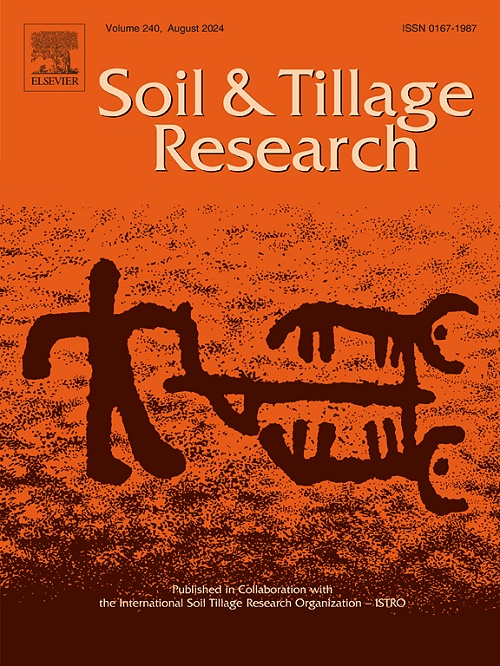冻融期浸出盐和还田秸秆通过优化土壤团聚体稳定性提高棉花解冻后产量和品质
IF 6.8
1区 农林科学
Q1 SOIL SCIENCE
引用次数: 0
摘要
季节性冻融循环加剧了新疆耕地盐渍化问题,严重阻碍了当地农业的发展。在这些周期中实施农艺措施以提高土壤性质对于缓解盐碱化和促进可持续农业至关重要。本文介绍了新疆盐碱区冬季灌溉与秸秆覆盖同时施用的效果。从2022年棉花生长季结束到2023年棉花生长季结束,进行了一项田间试验,采用了三个冬季灌溉定额(1800、2400、3000 m³ha⁻¹)和三种秸秆覆盖厚度(0,10 cm(800 kg ha⁻¹)、20 cm(1600 kg ha⁻¹),并进行了对照检查(CK),不进行灌溉或覆盖。我们评价了0-40 cm土层在冻融循环前后团聚体分布和稳定性、土壤盐分和土壤有机碳含量的变化。此外,我们还分析了2023年各地块棉花产量品质差异。结果表明:冬灌加秸秆覆盖显著提高了土壤大团聚体(>;2 mm),通过平均重量直径(MWD)和几何平均直径(GWD)测量,增强了骨料稳定性。冻融期0 ~ 40 cm土层土壤盐分降低,有机碳(SOC)含量增加,次年棉花产量和品质均有提高。后冻融、大型聚合内容,随钻测量,GMD,和SOC存储增加了1.59 % % -11.64,1.61 % % -21.61,12.80 % % -33.90,和12.80 % % -33.90,分别,而盐储存下降了37.71 % % -52.17。与对照相比,冬季灌溉和秸秆覆盖地籽棉产量提高844.70 ~ 2298.07 kg ha⁻¹。Pearson相关分析和主成分分析(PCA)表明,冬灌配秸秆覆盖通过提高土壤有机碳含量、降低耕层含盐量和提高团聚体稳定性来提高棉花产量和品质。在此基础上,建议在新疆盐渍土冻结前进行冬季灌溉和秸秆覆盖。本文章由计算机程序翻译,如有差异,请以英文原文为准。
Leaching salinity and mulching straws during freeze-thaw period enhance post-thawing cotton yield and quality by optimizing soil aggregates stability
The salinization of arable land in Xinjiang poses a significant barrier to local agricultural development, with seasonal freeze-thaw cycles intensifying the problem of soil salinization. Implementing agronomic measures to enhance soil properties during these cycles is crucial for mitigating salinization and promoting sustainable agriculture. This study presents the results of the simultaneous application of winter irrigation and straw mulching measures in saline areas of Xinjiang. A field experiment was conducted from the end of the 2022 cotton (Xinluzao 52) growing season to the end of the 2023 season, employing three winter irrigation quotas (1800, 2400, 3000 m³ ha⁻¹) and three straw mulch thicknesses (0, 10 cm (800 kg ha⁻¹), 20 cm (1600 kg ha⁻¹)) across, along with a control check (CK) without irrigation or mulching. We evaluated the 0–40 cm soil layer for changes in aggregate distribution and stability, soil salinity, and soil organic carbon (SOC) content before and after the freeze-thaw cycle. Additionally, we analyzed differences in cotton yield quality under each plot in 2023. The results showed that combination of winter irrigation and straw mulching significantly increased the content of large-aggregates (> 2 mm) and enhanced aggregate stability, as measured by mean weight diameter (MWD) and geometric mean diameter (GWD). This combination also reduced soil salinity and increased soil organic carbon (SOC) content within the 0–40 cm soil layer during the freeze-thaw period, leading to improved cotton yield and quality in the subsequent year. Post freeze-thawing, large aggregate content, MWD, GMD, and SOC storage increased by 1.59 %-11.64 %, 1.61 %-21.61 %, 12.80 %-33.90 %, and 12.80 %-33.90 %, respectively, while salt storage decreased by 37.71 %-52.17 %. Compared to CK plots, seed cotton yield in winter irrigated and straw mulched plots increased by 844.70–2298.07 kg ha⁻¹. Pearson correlation and principal component analysis (PCA) revealed that winter irrigation combined with straw mulching enhances cotton yield and quality by increasing SOC content, reducing salinity in the tillage layer, and improving aggregate stability. Based on our findings, we recommend the application of winter irrigation and straw mulching before the freezing of saline soils in Xinjiang.
求助全文
通过发布文献求助,成功后即可免费获取论文全文。
去求助
来源期刊

Soil & Tillage Research
农林科学-土壤科学
CiteScore
13.00
自引率
6.20%
发文量
266
审稿时长
5 months
期刊介绍:
Soil & Tillage Research examines the physical, chemical and biological changes in the soil caused by tillage and field traffic. Manuscripts will be considered on aspects of soil science, physics, technology, mechanization and applied engineering for a sustainable balance among productivity, environmental quality and profitability. The following are examples of suitable topics within the scope of the journal of Soil and Tillage Research:
The agricultural and biosystems engineering associated with tillage (including no-tillage, reduced-tillage and direct drilling), irrigation and drainage, crops and crop rotations, fertilization, rehabilitation of mine spoils and processes used to modify soils. Soil change effects on establishment and yield of crops, growth of plants and roots, structure and erosion of soil, cycling of carbon and nutrients, greenhouse gas emissions, leaching, runoff and other processes that affect environmental quality. Characterization or modeling of tillage and field traffic responses, soil, climate, or topographic effects, soil deformation processes, tillage tools, traction devices, energy requirements, economics, surface and subsurface water quality effects, tillage effects on weed, pest and disease control, and their interactions.
 求助内容:
求助内容: 应助结果提醒方式:
应助结果提醒方式:


